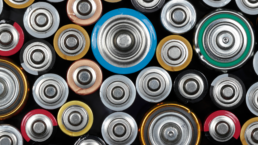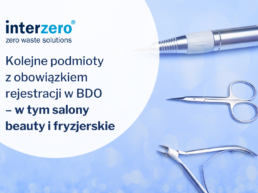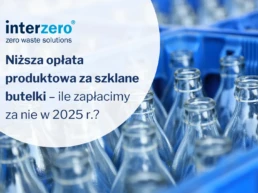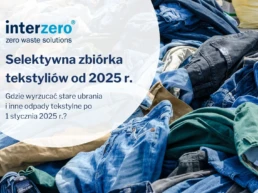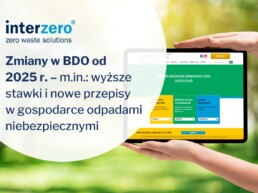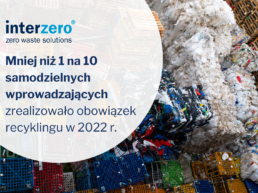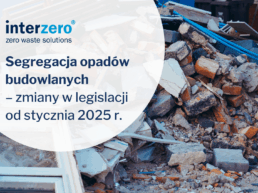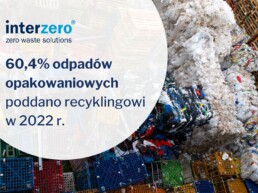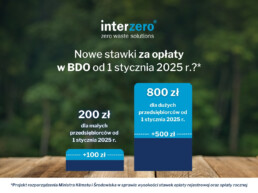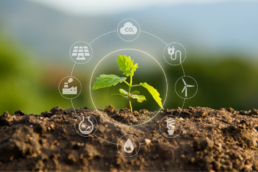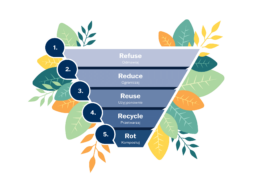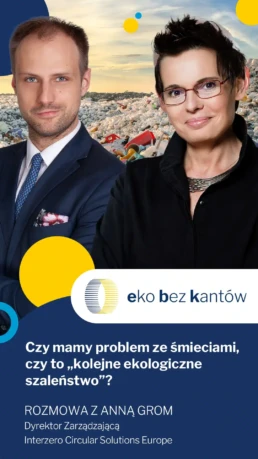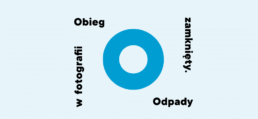Batteries
Removal of waste electrical and electronic equipment and batteries
Interzero allows you to obtain all necessary permits to collect, transport and process (in accordance with the Act) waste electrical and electronic equipment and batteries, including:
- IT equipment
- household appliances and electronics
- mobile and landline phones
- medical and laboratory devices
- other items and electronic equipment, including lighting
We offer fast and safe collection of equipment, in any quantity
We specialize in the collection and recycling of batteries, old electrical devices, packaging and other waste from industry, households and trade.
It doesn’t matter where and how you sell your batteries, we collect old batteries from local and regional collection centers, dealers, distributors and workshops.
The Interzero Group is the only supplier in Europe that organizes the international collection and recycling of batteries, old electrical appliances and packaging.
We are waiting for you. Contact us.
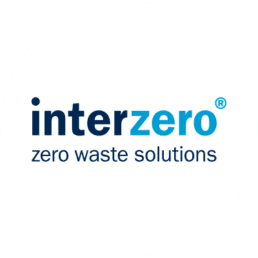
biuro@interzero.pl
+48 22 742 10 22
Kontakt
Actions for sustainable development
We are they
Our „we are one” corporate culture stands for respect, communication and responsibility. These values unite us – regardless of what work we do at Interzero, and regardless of our background, beliefs or choice of partner. Even just looking at Interzero in Germany, we find employees from 41 countries aged 16 to 67. We also work to ensure equal opportunities for our employees. We appreciate diversity, take an interest in our colleagues and learn from each other. Our competency model reflects a shared understanding of values and is a guide for all employees. It is also the starting point for stimulating commitment to the implementation of the zero-waste vision on a daily basis: we do not rest on our laurels, but try to find the right ways to fulfill this vision.


„Each of us can contribute to a sustainable corporate culture. As Sustainability Ambassadors, our employees can present their own ideas and sustainable projects that contribute to the success of the company. A wide-ranging team promotes these initiatives at Interzero: this keeps communication channels open and help us present sustainability as an ongoing process.”
Christine Kleinhammes
Senior Manager business development projects
Employee initiatives for sustainable development
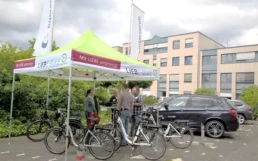
Together we can achieve more. That’s why our employees actively contribute to making Interzero a more sustainable company. Since 2016, our Sustainability Ambassadors have regularly organized Sustainable Development Week, involving employees in joint cleaning, sharing economy actions and commute programs that reduce CO 2 emissions. The city bike campaign is also very popular. Its aim is to cycle as many kilometers as possible in three weeks to contribute to climate protection and to raise awareness about the need to expand urban cycling infrastructure. In 2017, Interzero employees covered almost 7,500 kilometers on bicycles. This has reduced CO 2 emissions by approximately 1 tonne and saved €675 that would otherwise have been spent on fuel.
Go beyond the scheme: two steps
Companies have a key role to play in stopping global warming. What actions should they take to reduce global warming? The strategy adopted as part of the initiative „The road to economy <2°” is: „We achieve more when we work together.” With an interdisciplinary approach, it unites diverse industries, specializations and perspectives to make progress towards a common goal. Interzero, together with about 40 other companies, is an active participant in this pioneering project which was launched by the 2° Foundation and WWF Germany.

Ideas for a sustainable economy

As experts in the field of circular economy, we share our specialist knowledge by building a dialogue with researchers, business and the public. One such activity is the Center for Sustainable Corporate Governance, a joint initiative of the business and R&D sectors based at Witten/Herdecke University in Germany. We support the working group on recycling, as well as the development of the „More Sustainable Business Food” standard.
We also support the following projects:
- Environmental education projects in cooperation with clients (McCormick, Dell, Mlekovita) (Poland)
- Eco garden at the Integration School in Warsaw (Poland)
- KidS (Köln)
- Jugend am Werk (Austria)
- Wiener Tafel (Austria)
- Verein Albatros eV (Wiesbaden, Germany)
- kids (Germany)
- Aktion Friedensdorf eV (Germany)
- Erzbischöfliches Kinder- und Jugendheim St. Kilian (Germany)
- Sponsorship for Geyserhaus (Germany)
- Red Cross – honorary blood donation (Germany)
- DKMS (Germany)
Kontakt
newsletter
newsletter
Stay up to date with environmental industry news! Follow legal updates and be the first to know!
Subscribe to the Interzero newsletter
Sign up for the Interzero newsletter to receive information relevant to the environmental protection industry. Every month a fresh dose of knowledge and news from the world of ecology and sustainable development!
Environmental consulting
Environmental consulting
Professional consulting in the area of broadly understood environmental protection conducted by a qualified team of experienced specialists operating in the areas of air emissions, water and sewage management, waste management and packaging.
Kontakt
Sustainability performance reporting
Sustainable Development Report 2020
In the 2020 Sustainability Report, Interzero presents a comprehensive account of its social and environmental achievements for the fifth time. In this way, Interzero shows customers, employees, suppliers and the public what values the company follows in its daily activities, what impact its economic activities have on society and the environment, and how its progress in the field of sustainable development looks like.
The report complies with the requirements of the Global Reporting Initiative and was prepared in accordance with the GRI Standards: „core” variant.
Unless stated otherwise, the key data and information presented relate to the financial years 2019 and 2020.
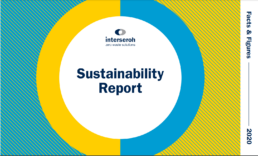
Download the 2020 Sustainability Report
You can read about how we manage sustainability, what our goals are, and how far we’ve come on the road to a waste-free future in our 2020 Sustainability Report.

Download the 2020 sustainability magazine
We look for connections between environmental protection and economic development and in this way we create added value. Our new sustainability magazine „Building bridges. Closing circles.”
Downloads _ _
Our locations
Nasze lokalizacje
Grupa Interzero w Polsce
WARSZAWA
Interzero Packaging Recovery Organization SA
st. Wiertnicza 165 02-952 Warsaw, Poland
Management Board: Anna Grom, Monika Grom, Paweł Lesiak, Agata Ryś NIP: 5213409980
Address for correspondence:
Interzero Packaging Recovery Organization SA
st. Wiertnicza 165 02-952 Warsaw, Poland
CRACOW
Interzero Packaging Recovery Organization and Electrical and Electronic Equipment Recovery Organization SA
st. Mogilska 65 31-545 Krakow, Poland
Management Board: Monika Grom, Paweł Lesiak, Agata Ryś NIP: 9512530326
Address for correspondence:
Interzero Packaging Recovery Organisation and Electrical and Electronic Equipment Recovery Organisation SA ul. Mogilska 65 31-545 Krakow, Poland
Interzero Polska Sp. z o.o.
ul. Wiertnicza 165
02-952 Warszawa
Zarząd: Monika Grom, Paweł Lesiak
NIP: 9512367010
Adres korespondencyjny:
Interzero Polska Sp. z o.o.
ul. Mogilska 65
31-545 Kraków, Polska
ŁÓDŹ
Interzero Advisory Sp. z o.o.
ul. Wiertnicza 165,
02-952 Warszawa, Polska
Zarząd: Monika Grom, Paweł Lesiak
NIP: 1132335293
Adres korespondencyjny:
Interzero Advisory Sp. z o.o.
ul. Wólczańska 178 budynek A
90-530 Łódź, Polska
Environmental education
Interzero educational campaigns
companiesy which introducesI on market products in packagingch, batteries or electrical or electronic equipment hasI the obligation to conduct public educational campaigns. their citem Is increasing awareness ecological society, especially in terms of progressivenia with waste. Environmental Education Team interzero Youfulfills this obligation on behalf of clientsby implementing, among others projects like Eco without edges, Ekopaka , or Zero Waste Office.
EkoPaka - how to explain to children what recycling is?
EkoPaka is a multidimensional educational program aimed at preschool and early school children. It teaches through fun and creative work based on substantive materials developed by experts. It supports teachers and educators by providing them with reliable knowledge about the closed loop of raw materials.
The program includes, among others: educational kits whose content helps in carrying out active, engaging classes with students. They consist of ready-made scenarios, educational coloring books, art and creative materials, educational tools and games enabling effective education in the field of environmental protection and ecology. So far, we have created materials and kits focused on waste fractions:
The potential of the program is growing year by year. Our experience of cooperation with schools, libraries, cultural institutions and entrepreneurs confirms that we learn best and fastest by experiencing. EkoPaka enables the creation of such wise education, which can be easily incorporated into larger initiatives such as school or company picnics, employee campaigns, ecological competitions, but also into smaller ones such as home education.
Zero Waste Office - how to create an ecological workplace?
For us, a sustainable workplace means wise resource management, a responsible team and attention to environmental issues. Taking into account such a broader perspective in business very often allows you to find savings and new development potentials by strengthening communication and cooperation.
Zero Waste Office is a comprehensive service, the starting point of which is the assessment of office space in terms of sustainable development. The research from which we start has a very wide scope - apart from the issues of workplace organization, it also considers the ways of functioning or habits of employees.
Changing the culture of an organization to an environmentally friendly one is a challenge. That is why we offer support in designing the office transformation process and internal employee education. We also provide technologies that facilitate waste management and build environmental awareness.
The Zero Waste office is a scalable service that can be adapted to both large and small companies. We also have experience in working with the public sector. With our support, every office can be certified as a Zero Waste Office.
Eco without edges , or how to avoid greenwashing
In „Eco without edges” we talk about ecology without bending reality. We deal with myths, fake news, half-truths. Our goal is to explain why you should separate waste, not just how to do it correctly.
„Eco without edges” was created out of the belief that in a world full of disinformation and greenwashing you need a credible place with reliable news. We present the topics of sustainable development, recycling, closed circulation, and EU legislation related to waste management. We discuss the environmental impact of packaging, batteries, e-waste and how to use them as secondary raw materials. The heart of this public education campaign is website . This website was indicated as the best source of knowledge about waste and packaging by the respondents of the consumer survey.
On the website you will find :
- search engine for over 1000 wastes,
- consumer research reports,
- project publications,
- thematic articles,
- podcasts with experts.
We cordially invite you to join the „Eko bez Kantuj” community on the platforms Instagram, Facebook, YouTube, Spotify, Apple Podcasts.
Kontakt
Do you want to run an effective eco-educational campaign?
Contact us.

biuro@interzero.pl
+48 22 742 10 22
Plastic recycling
Plastic recycling - replacing waste into high-quality regranulate
The Recycled-Resource plastics recycling process allows you to close the raw material cycle and obtain high-quality regranulate in accordance with the customer's specification. Get to know our unique materials: Recythen® and Procyclen® - extremely ecological, 100% recycled and fully tailored to your needs.
Improved plastic recycling – discover Recycled-Resource
Recycled-Resource is an innovative, award-winning plastic processing process that allows you to obtain high-quality regranulate with properties tailored to customer needs .
The Recycled-Resource process was created for the most demanding customers who want to obtain regranulate with specific mechanical parameters and in the most environmentally friendly way. To meet these expectations, our plastic recycling technology is constantly developed and improved . Key research and development work takes place in our new competence center in Maribor, Slovenia.
Our portfolio of recycled plastics
At our three recycling plants , we process a wide range of plastics and polyolefins into clean recyclates . Our recycling process mainly focuses on several plastics: LDPE, HDPE, PP, PET and EPS.
At the processing plant in Eisenhüttenstadt in Brandenburg, we use plastic packaging waste: polypropylene (PP) and polyethylene (PE) to produce recyclate of uncompromising quality and high reusability.
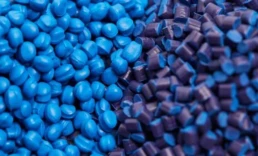
Our offer of recycled plastics is complemented by: LDPE granulate and rPET regranulate produced at the plant in Liebenau and EPS processed at the installation located in Aschersleben.
- LDPE granules are recycled, clean, high-quality plastic that we produce at the request of companies operating in the processing industry.
- Recycled EPS has a wide range of applications in various industries: from the production of consumer goods to use in construction.
- From 2023 we use a PET extrusion installation, thanks to which we close the raw material cycle and obtain rPET granules for the food retail sector.
Our offer includes both regranulates and regrinded plastics for the processing industry.
Recythen® and Procyclen® – high-quality plastic regranulate
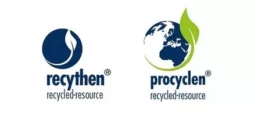

As a result of the Recycled-Resource process , two types of plastic granulate are produced – Recythen ® and Procyclen ®. We obtain raw materials for their production from household waste, mainly packaging made of polyethylene (PE) and polypropylene (PP).
Procyclen® is an award-winning recycled material whose properties can be modified in a very wide range. By changing the formula, Procyclen® produced in our plant in Germany can be adapted to customer requirements in terms of fluidity, stability, resistance to ultraviolet radiation, temperature and color . Moreover, Procyclen® meets the strict requirements for plastics used in the production of new products and packaging and can be used for injection molding and extrusion processes.
Our second type of regranulate – Recythen® – can be used to produce products such as cable reels, garden furniture, drain pipes or cable channels.
Manufacturers who use Recythen® or Procyclen® in their plastic products can apply for the Blue Angel environmental label .
What will you gain by choosing Recycled-Resource - advanced plastic recycling from Interzero?
Certified, repeatable quality of materials
Production technical support
Detailed technical documentation for all batches of recyclate
Security planning and security of supply
Upcycling possibilities and full compliance with REACH regulations
Real impact on the preservation of the earth's natural resources
Choose plastic recycling from Interzero and protect the environment
Using our recycled plastics you contribute to reducing greenhouse gas emissions into the atmosphere and help protect the planet’s natural resources. The use of Procyclen® and Recythen® helps reduce the company’s negative impact on the environment, which was confirmed in a study published by Fraunhofer Institute UMSICHT.* Thanks to these raw materials, climate-harmful emissions can be reduced by up to 59% and primary energy consumption can be significantly reduced**.
* Calculations are based on the ISO 14040 and 14044 life cycle assessment standards. The compared technologies correspond to the current state of knowledge. All results refer to one tonne of granules.
** Assuming consumption of 0.50 kWh per wash. This corresponds to energy efficiency class A.
Entrust your plastic recycling to Interzero and reduce your CO2 emissions
Such impressive statistics and environmental benefits motivate us to work hard to further improve our plastic recycling process. Interzero constantly strives to increase the efficiency of the Recycled-Resource process and thus reduce the burden on the environment.
The production of the latest generation of Procyclen® takes place in one process step and consumes much less energy. Thanks to this , we can achieve up to 50% reduction in greenhouse gas emissions, reduce the costs of the entire plastic recycling process and contribute to the preservation of valuable natural resources.

Achieving such impressive results and huge environmental benefits is possible thanks to the use of the innovative COREMA® cascade extrusion system. It allows for individual programming of each plastic recycling procedure in such a way as to obtain regranulate in just one production stage that is 100% compliant with the customer’s needs and order. In April 2019, environmental services provider Interzero and technology manufacturer EREMA received a PRSE award for this innovation in the „Recycling Machine Innovation of the Year” category.
Interzero technologies that have gained international recognition
Plastics obtained in the Interzero material recycling process enjoy constantly growing interest from producers and distributors. Our Recycled-Resource process and Procyclen® regranulate have also won many prestigious awards .
Plastic Recycling Awards Europe 2020:
- nominated together with HOUE Design ApS in the „Household and leisure product of the year” category for the „FALK Chair”
Plastic Recycling Awards Europe 2018
- nominated in the „Best recycled plastic packaging” category for the „memo Box” reusable shipping system from memo AG
- In the „Ambassador of the Year of Plastic Recycling” category – for people who have made a special contribution to plastic recycling – the nominee was Dr. hab. Manica Ulcnik-Krump, Managing Director of the Competence Center in Maribor
In March 2020, our competence center in Slovenia received official international accreditation, making it the only recognized research institution in the EU specializing in the development and analysis of recycled plastics. Thus, Interzero has become a pioneer in the implementation of uniform quality standards throughout Europe.
Do you want to see the benefits of using our regranulates: Recythen® and Procyclen® in your company?
Write to us and discover a range of new possibilities thanks to the most effective plastic recycling from Interzero!
Reports and certificates New
Resource conservation and climate protection
Interzero works with customers and partners to close raw material loops and achieve long-term climate change mitigation and resource conservation. The prestigious Fraunhofer UMSICHT publishes studies confirming the positive ecological effects of our work.
Customer login
Please enter your access code which you have received via email or post.
Scientifically proven climate protection
In its annual study “resources SAVED by recycling”, the Fraunhofer Institute UMSICHT calculates the extent to which the environment has been helped by Interzero’s recycling services. In 2022 alone, this study showed that 2.1 million tonnes of resources were handled by closed-loop systems run by Interzero’s companies such as Interzero in Germany, Austria, Poland; Italy and Slovenia, saving around 8.7 million tonnes of primary raw materials . This is comparable to the weight of 174,267 single-family homes . The companies also saved around 1 million tonnes of greenhouse gas emissions – this corresponds to the average annual CO 2 emissions of over 100,000 four-person households .
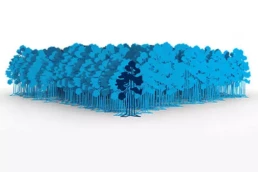
Reducing transportation, reusing IT devices
In another study from the “resources SAVED” series, Fraunhofer UMSICHT looked at the positive impact on resources and the climate from the refurbishing and reuse of IT and communications devices , as organized by Interzero. As one example, using refurbishment to extend the service life of just one laptop saves around 181 kg of primary raw materials and 154 kg of greenhouse gas emissions.
Interzero’s Mobile Counting Center (MCC) also helps save resources. The local availability of the mobile counting service for non-refillable bottles means companies avoid long trips to stationary counting centers. “resources SAVED” shows that the MCC’s annual CO 2 savings equal the amount removed by around three wooded football pitches.

„From recyclable product design to sustainable recovery, successful circular transformation requires all stakeholders in the value chain to pull together. „
Dr.-Ing. Marcus Hiebel
Head of Department Sustainability and Resource Management Fraunhofer Institute UMSICHT
8,713,378
In 2022, Interzero conserved 8.7 million tonnes of primary resources by recycling 2.1 million tonnes of raw materials.
978,569
The recycling activities of Interzero reduced greenhouse gas emissions by 1 million tonnes in the past year.
2,339,396
Recycling of electrical appliances saved more than 2.3 million tonnes of primary resources.
721,353
The company processed more than 700 million tonnes of paper, paperboard and cardboard, thus avoided round about 180,000 tonnes of greenhouse gas emissions.
513,272
A total of more than 500,000 tonnes of used glass was recycled, which reduced the use of primary raw material by 1 million tonnes.
577,353
The company recycled more than 570,000 tonnes of plastic, thereby conserving more than 2 million tonnes of primary raw materials.
"resources SAVED" certificates for our customers and partners
Sustainable competitive advantage: In cooperation with Interzero, you improve your ecological footprint and strengthen the bond with your customers. We show the amount of primary raw materials and greenhouse gases saved with us in your individual resource protection certificate, measured by your individual contribution – whether this is through recycling, the reuse of IT equipment or the reduction of transport routes.
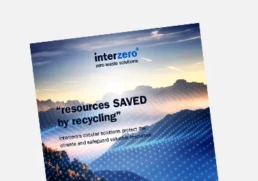
Kontakt
Reports and certificates
Scientifically proven resource efficiency
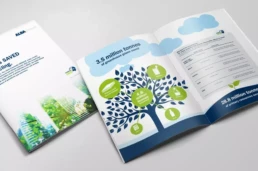

„Recycling is an important part of a sustainable society: it saves resources and reduces greenhouse gas emissions and reduces economic dependence on imported raw materials. The study clearly shows the important role played by companies like ALBA Group.”
Dr.-Ing. Markus Hiebel Director of the Department for Sustainable Development and Resource Management of the Fraunhofer UMSICHT Institute
12.545.215
Interzero saved 12.5 million tons of primary resources by recycling 1.8 million tons of recyclable materials.
978.256
Interzero's recycling activities have saved 1 million tons of greenhouse gas emissions.
2.123.289
2 million tons of primary raw materials have been saved by recycling electronic devices.
574.855
The company recycled 575,000 tons of paper, cardboard and cardboard, thus saving approximately 183,000 tons of greenhouse gas emissions.
366.897
We recycled over 365,000 tons of glass waste, reducing the use of virgin raw materials by 800,000 tons.
355.529
The company recycled over 350,000 tons of plastic, thereby saving over 1.2 million tons of primary raw materials.
Resources SAVED by recycling - certificates for our clients and partners
Sustainable competitive advantage: By partnering with Interzero, you can reduce your ecological footprint and strengthen customer loyalty. Interzero demonstrates your company’s contribution to resource efficiency with a certificate. Each asset protection certificate and all relevant information can be viewed by logging into our Resources SAVED portal. Simply enter the password you received with the certificate.
Portal "resources SAVED by recycling"
Are you our client and want to download the „Resources SAVED by recycling” certificate? Go to the portal and log in using your individual access data.
We are waiting for you. Contact us.

